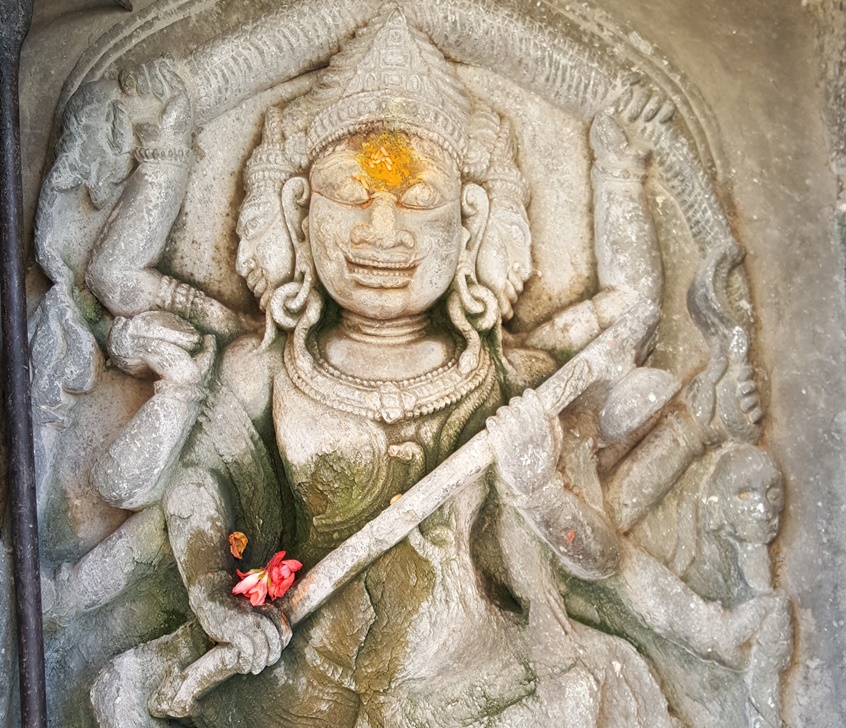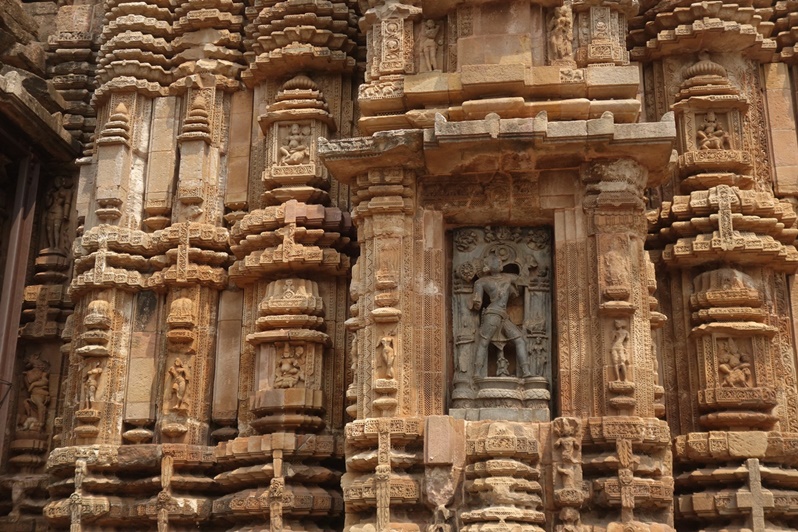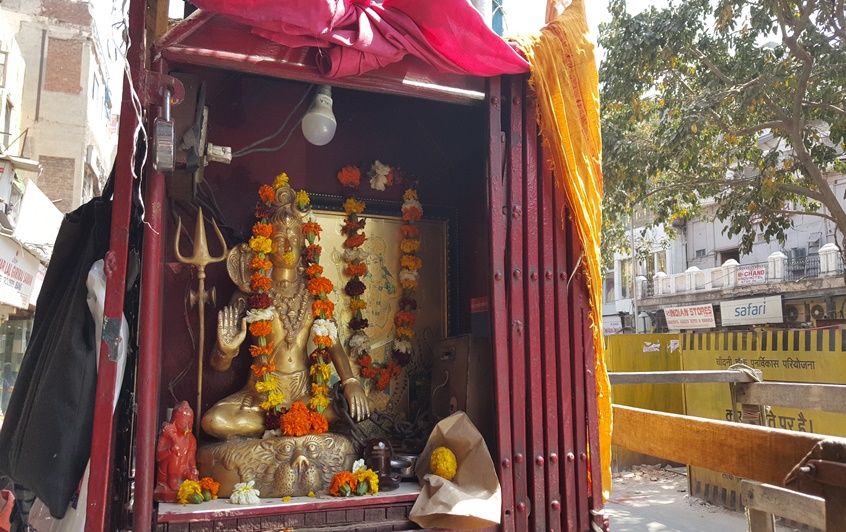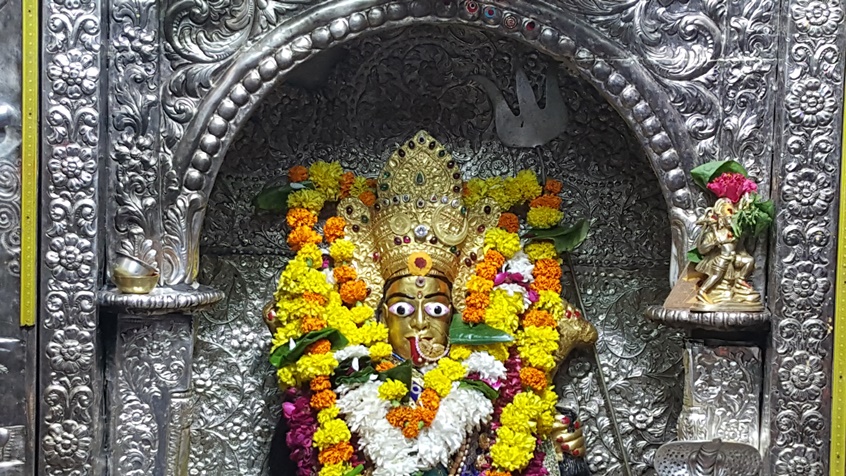
par Bertrand Bellaize, le 12 mai 2020
Art indien : les attributs des dieux hindous dans les statues indiennes 2
Art indien, les attributs des dieux indiens... suite :
Parmi les attributs des divinités dans les sculptures hindoues, les armes forment la catégorie homogène la plus importante et représente l’aspect actif : le cheminement spirituel relève pour une part du combat, mais il s’agit d’un combat intérieur (et non une guerre à mener contre un ennemi extérieur comme beaucoup le croit !). Même si les mythes relatent de nombreuses guerres contre les démons ou entre les divinités, celles ci sont des allégories : chaque démon, chaque bataille entre divinités dévoile une fausse croyance, un poison tel que les nomme le Bouddhisme qui habitent au plus profond de nous et qui parfois dictent notre conduite sans même que nous en ayons conscience (ainsi Durga Mahashasuramardini terrassant le démon buffle qui représente la vanité, les forces instinctives…).
Par ailleurs, on peut signaler que certains attributs possèdent plusieurs fonctions tels la conque qui peut être utilisée à la fois comme arme mais aussi comme symbole.
Les objets de rituels
Cloche
Ghantâ, incarnation du son primordial (comme la conque et le Damaru).
Conque
Shanka, le son grave éloigne les démons mais surtout symbolise l’infini et l’expansion, attribut de Vishnou (spirale dans le sens d’une montre) ou inversement de la destruction, alors attribut de Shiva.
Cuillère
Sruch sert à verser l’huile, le ghee (beurre clarifié) dans le feu lors des rituels : elle servait aussi, lors des rites sacrificiels, à verser les oblations. Signe de la générosité d’une divinité, de sa position bienveillante mais surtout de son pouvoir de transformation.
Lampe à huile ou à ghee
Dipa : symbole de lumière, de clarté, de connaissance qui dissipe les ténèbres.
Tambour à boules fouettantes
Damaru, petit tambour à boules fouettantes : représente le son originel, celui qui précède la manifestation mais aussi le changement, les différentes rythmes qui se succèdent les uns aux autres (pulsations).
Les animaux
Les animaux sont surtout figurés comme montures des divinités mais quelques uns sont présents en tant qu’attributs dans les statues.
Antilope
Mriga, attribut de Shiva, cet animal est considéré comme magique en Inde : lorsque elle est sculptée avec Shiva, debout, bien campée sur deux jambes arrières, elle indique sa maîtrise des forces de la nature.
Cobra ou serpent
Naga, symbole de régénération, de changement perpétuel et de l’énergie latente. Par ailleurs, les cobras peuvent aussi lorsqu’ils sont unis former un dôme protecteur sur la tête d’une divinité.
Mangouste
Nakula : symbole de la richesse, attribut de Kubera, le dieu de la richesse.
Les instruments de musique
Flûte
Murali, sa musique envoûte le fidèle et le transporte vers le divin.
Luth
Vina procure l’harmonie lorsqu’elle est jouée par une divinité : les statues de Saraswati la représente souvent avec un luth. Il en est de même avec Nârada et parfois Shiva.
Attributs divers des dieux hindous
Bâton
Danda indique la fonction de guide du dieu mais il peut aussi servir d’arme redoutable (par Shiva notamment). Surmonté d’une tête de mort (Khatvangha), il représente l’impermanence mais aussi l’aspect courroucé d’une divinité.
Bol ou sébile du mendiant
Patra symbolise l’ascèse et le Bouddha lui même.
Quand on le voit sous une forme de crâne, Kapâla, il signifie le pouvoir sur la mort.
Chapelet
Mâla réalisé à partir de 108 perles de Rudrakasha pour les fidèles de Shiva et de Tulasi pour ceux de Vishnou : il incarne le temps.
Kali porte parfois un chapelet fait de têtes de mort : Kapalamâla symbolisant la précarité de l’existence, l’impermanence de toutes choses.
Crâne
Kapa (voir Chapelet)
Chasse mouche
Chamara, réalisé en crin de yak, il peut représenter le souffle de l’esprit qui chasse les obstacles. Il est symbole de royauté. Plus basiquement, il sert à chasser les nuisibles, tout ce qui est indésirable, tout ce qui empêche.
Crochet à éléphant
Anhuska sert à orienter les éléphants dans la bonne direction et par extension les disciples. Il signifie la clairvoyance de celui qui guide.
Feu
Agni, à la fois lumière et destruction (seule possibilité de renouvellement).
Joyau
Ratna indique les richesses, l’aspect royal des divinités.
Livre
Pustaka symbolise la connaissance, surtout celles des Védas mais aussi la création car le Verbe précède la manifestation, la création du monde des formes. Il peut être ainsi associé au lotus.
A suivre...
Sources
The Book of Hindu Imagery: Gods, Manifestations and Their Meaning : Eva Rudy Janssen
Un et multiple : Sarah Combe
Mythes et dieux de l’Inde : Alain Danielou


